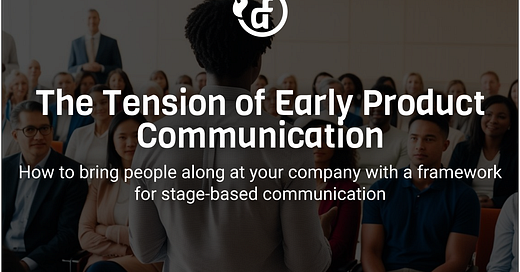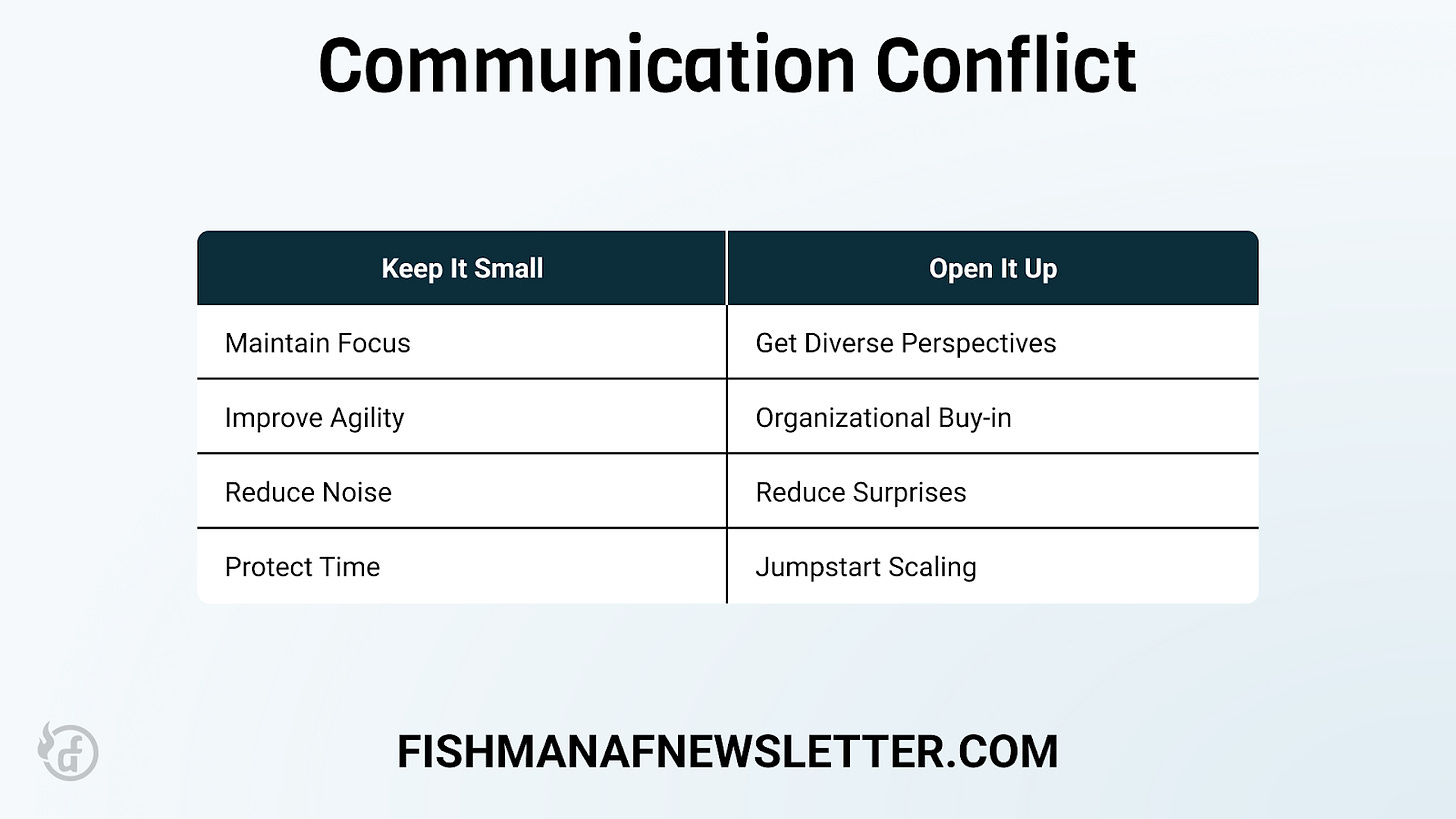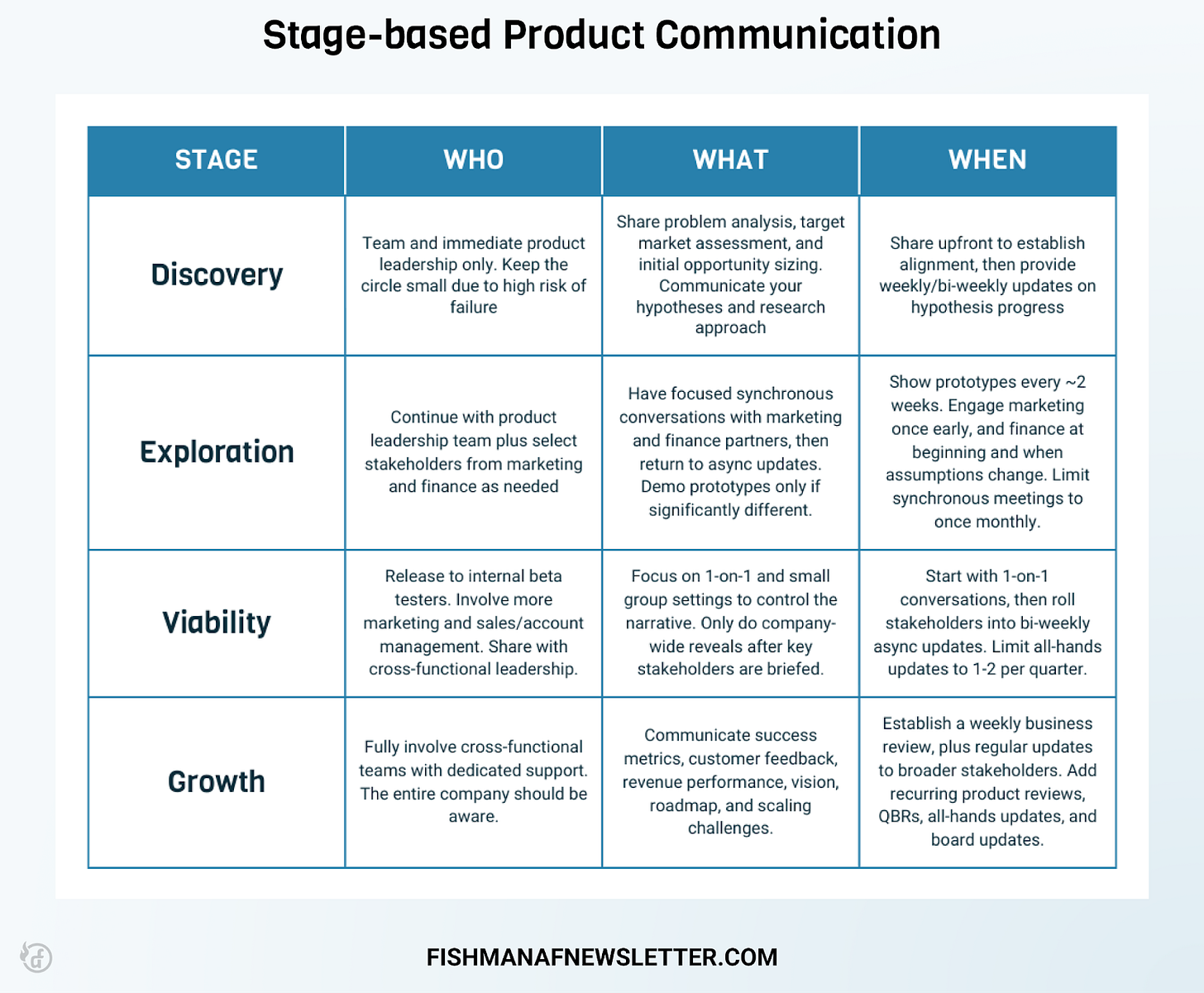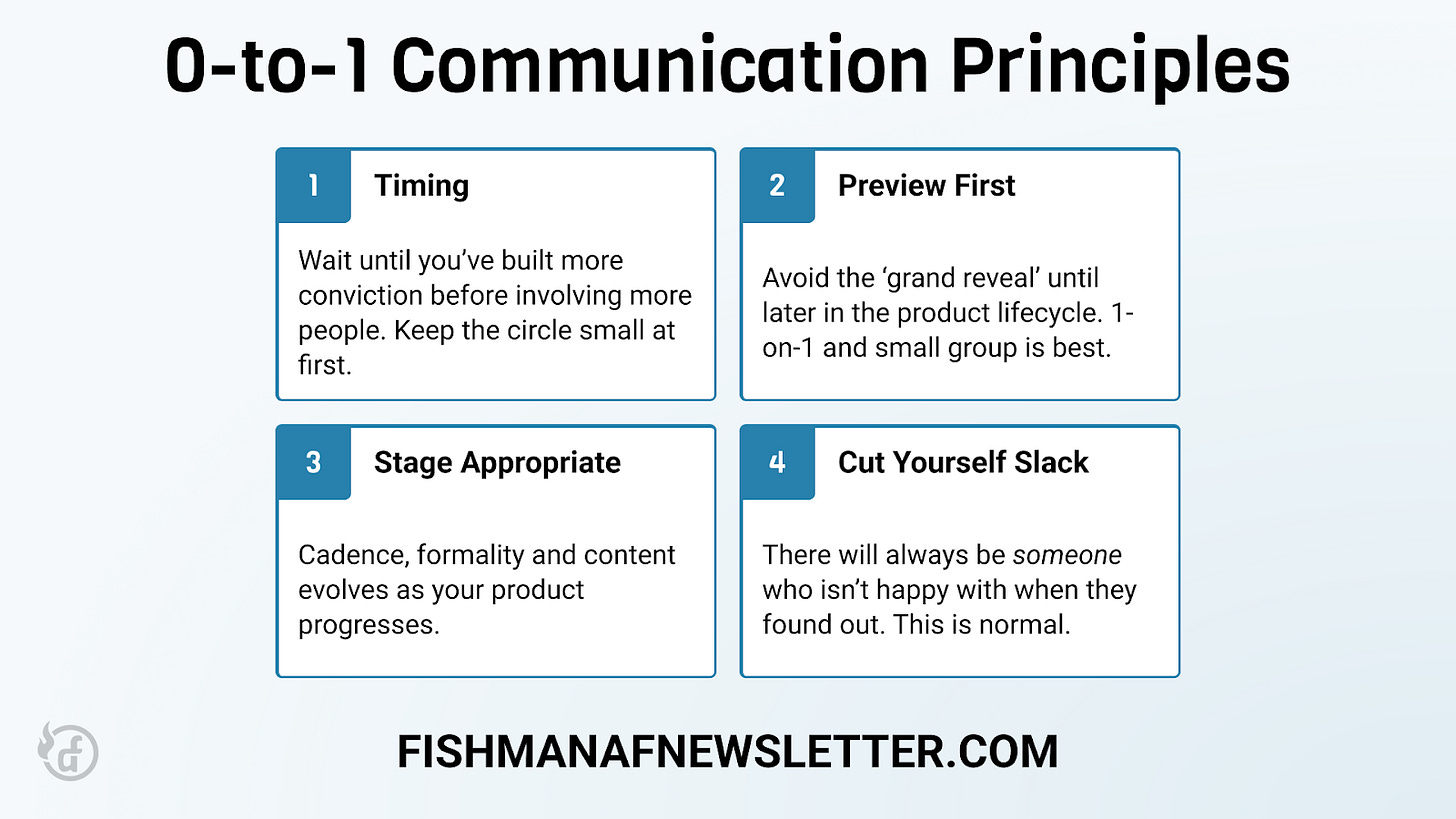The Tension of Early Product Communication
How and when to bring people along at your company with a framework for stage-based communication
Hi there, it’s Adam. I started this newsletter to provide a no-bullshit, guided approach to solving some of the hardest problems for people and companies. That includes Growth, Product, and company building. Subscribe and never miss an issue. If you’re a parent or parenting-curious I’ve got a podcast on fatherhood and startups - check out Startup Dad. Questions you’d like to see me answer? Ask them here.
Q: My biggest struggle right now is figuring out the right level of internal communication to deliver about this 0-to-1 project I’m working on. Our leadership team is along for the ride and gets regular updates, but I don’t know when we should start bringing the rest of the company along and getting them excited. I know some will be upset that they weren't closer to it from the beginning.
The struggle is real! Building a new product and finding product/market fit is hard enough. But doing it inside a larger company adds an extra-special challenge: how do you communicate progress without wasting time or creating premature expectations?
As stakeholders, we hate finding out about initiatives at the last minute. As builders, we have actual building to do and don't want to waste time creating updates for products that might fail.
While there's no perfect solution, a stage-based communication framework can help you strike the right balance - keeping your team focused while bringing the right people in at the right time…and maybe only irritating a handful of people who would probably be irritated anyway.
A Stage-Based Communication Framework
Your new product idea has a lifecycle and as you progress through that lifecycle from idea to actual product to revenue a few things happen:
Your conviction improves and your vision crystallizes
Your product improves
Your target customer (ICP, or whatever you’re calling it) becomes clear
The cone of uncertainty gets narrower
You invest more in that product
There are ~5 stages a successful product will progress through:
Discovery
Exploration
Viability
Growth
Sustain
Only the first four really matter for internal communication—by the time something reaches the ‘sustain’ phase it should be a core part of the company’s product experience and communication looks like that of any other mature product.
Let’s break down the first four stages and how you should be thinking about who, what and when to communicate at each stage.
Discovery
This is the earliest stage of product development for a 0 to 1 product. Here you’re trying to establish problem/customer fit. You’ll want to understand whether a problem is worth solving, how it's solved today and whether the market is attractive enough to go after.
Who
Given that it’s very early and a product idea in this phase has a very high risk of failure, you want to keep the communication between the team and immediate product leadership only. It’s not worth getting other parts of the company excited (yet) and you won’t need their support at this early stage.
What
Keep this focused on the problem space, the opportunity size and whatever information you have in these two areas that supports answering the question: is this a problem worth solving?
When
It makes the most sense to share out up front to establish a foundational level of alignment even if you don’t have all the inputs yet. It provides directional guidance on the area you’re exploring and allows for feedback and uncovering of insights that may live within the heads of your product leadership team.
Following this, providing a short weekly or bi-weekly update on progress towards (dis)proving your hypotheses is valuable. It creates accountability for you and your team during a stage where you can waste a lot of sideways energy on research. It also helps your leadership team maintain context and provide better feedback to you.
Temptations to avoid
Polish. No one will remember how polished your slides were if the product fails; at this stage the risk of failure is highest.
Synchronous product leadership updates. These should be scheduled ad-hoc only; instead, prioritize quick async communication in written form.
Telling your friend elsewhere in the company. Don’t do it; it’s a slippery slope.
Exploration
You move into Exploration when you start to tinker with solutions to the problem you identified in the Discovery stage. In getting here you should already have a rough market opportunity size, understand the problems worth solving and for whom, and a sense of the business model for a product in the space (at a minimum some sense of how you expect to monetize this product). You want to spend time here testing solutions to figure out which one is right for your customers and whether they’re technically feasible (spoiler: they are).
Who
You don’t want to open up communication too much here because you’re still quite a distance from product/market fit. Continue with the immediate product leadership team and consider opening up to select stakeholders as needed across sales, marketing, finance, or operations. Marketing and finance are your first two touchpoints for a few reasons:
Marketing can help you with some positioning and basic branding.
You’ll want Finance in to help you pressure test your financial assumptions and build conviction with them for the next phase of development which requires more investment.
You still don’t need much support from other parts of the company so it’s best not to poke the bear. You run the risk that they’ll smother your new product with a bit too much love and “help.”
Eventually, you’ll test a solution internally and you’ll open this up to more team members, but not until later in the exploration process.
What
It’s worth it to have a few synchronous conversations and then return to async updates. Have a short positioning exercise with a product marketing partner and work with your finance partner to construct a basic financial model and outline the assumptions you’re making (they’ll eventually be helping you build a higher-fidelity model and a happy finance partner is your friend so start now). Demoing prototypes to your immediate product leadership is valuable but only if each iteration is significantly different from the prior one. Otherwise an async update and sharing some customer feedback should suffice.
When
You’ll want to show prototypes on a ~2 week basis or however long it takes your team to make meaningful progress between iterations. Engaging with the marketing team can be done once, early in this stage and with finance you’ll want to engage at the beginning of the stage and then again as your model assumptions change. I would avoid meeting synchronously more than one time per month.
Temptations to avoid
All hands / all company updates. It’s not time yet. If you do show the product iterations outside of small demos with the stakeholders above repeat the word “prototype” until your lips go numb.
Lofty promises to your finance partners. At this stage you’re not anywhere close to the next $100M ARR product in the portfolio. It’s important to know what it’ll take to get there, but for now no promises!
Building excessive hype with broader company leadership. I don’t care if performance review season is upon you and you’re on the hunt for that elusive promotion; one glimpse and they will immediately want to know how they can get involved. This is the opposite of what you want at this stage.
Viability
This is where the rubber meets the road in your quest to find product/market fit. You’ll start to get some real metrics, crystallize your growth and GTM plans, and add to your team. You’re collecting broader internal feedback, validating that customers are willing to pay for your solution and that the unit economics make sense. This is the point where you start to engage more people across the organization while balancing the risk that this product still might not get to PMF. Remember: that risk is still very real.
Who
You’ll release your product to beta testers inside the company which naturally extends the circle of awareness. The key here is “internal beta” or “dogfooding.” It sets the expectation that you’re still early and working out some of the details. For people you expand it to, it's important that they understand your vision for this product – so give them a brief roadshow and manually onboard them like you might any other customer. Also, be specific in the type of feedback you’re looking for and what the limitations of the product are currently.
You’ll want to involve more folks in marketing and (depending on your target customer) sales/account management. These are the folks who can help you get enough traction to find reference customers and meaningfully measure retention. You’ll want to tighten up positioning and update your financial model with new data as well.
It’s time to share more information with cross-functional leadership as well. If only to get their feedback and warm them up for the help you’ll eventually need from their team members. Much like your dogfooding audience the leaders of the company will be interested in the bigger picture vision of where you’re headed.
But Adam, when do I do that fancy all-hands presentation?
After you’ve engaged 1-on-1 and in small group settings with the stakeholders above it’s time.
What
The key is 1-on-1 and small group settings. This helps you control the narrative, explain the vision and limitations, and receive direct feedback. You can also provide some contextual relevance so they see how their work will contribute to the success of this product. Avoid the grand reveal at all hands until you’ve met with the people and functions who are instrumental to the product’s success. Only then is it time to turn on the hype, pyrotechnics and strobe lights company-wide.
When
I recommend an up-front 1-on-1 or small group conversation and then rolling those stakeholders into an every-two-weeks asynchronous update. Treat it like how a CEO/founder might effectively communicate with their board (but don’t tell the board yet, please don’t). Your all-hands updates will vary depending on how frequently your company does them, how packed the agendas are, and how much has changed since the last update. One or two updates per quarter is good enough.
Temptations to avoid:
Telegraphing to the board. Unless it’s clear that this product is on the cusp of meaningfully contributing to revenue I would avoid overhyping to the board. You may bundle it in a group of products that showcase “interesting things we’re working on” but leave it at that for now.
Building into annual financial forecasts. There will be temptation and pressure to do so, but start conservatively as the variability can still be quite wide here.
The grand reveal. This is fine after you’ve done the grassroots work of bringing key stakeholders along for the ride. But the last thing you want is one of your immediate, internal partners (who will be instrumental in helping you scale) finding out about this through a company-wide meeting.
Growth
Congratulations, you’ve got a full-fledged product that is post-product/market fit. How do you know? A flattening retention curve, consistent positive feedback and steady growth of paying customers will push you into this next phase of the product lifecycle.
Who
At this point you’ll fully involve cross-functional teams and have dedicated team members supporting your product. The whole company should be aware of it and you’re treating it like a core part of your offering.
What
You’ve got a growing product now so you’ll want to communicate success metrics and progress, feedback from customers, revenue performance, your forward-looking vision and roadmap, and any scaling challenges you might be experiencing.
When
This is the point in time where you can construct a weekly business review. Combining this with a regular cadence of weekly or bi-weekly updates to a broader set of stakeholders and company leaders is also important. Depending on what else your company does to stay aligned and communicate progress you might consider:
Recurring product reviews
Quarterly reviews with leadership (QBR)
Regular, recurring updates in your all-hands meeting
Public Slack channels for regular updates
Board updates
Conclusion
The work of building a new, 0-to-1 product inside a bigger company is hard. It’s really hard. When you’re an early-stage startup building your first product you don’t have internal stakeholders, partners, a marketing team, a sales team, or finance. You don’t have policy people, lawyers, or even… customers. This communication process doesn’t even apply at the earliest stages.
But when you’re inside of a larger company you’ve got to manage all of those people.
There are a few universal principles that you can fall back on when making decisions across stages:
Timing is everything. At the earliest stages keep the circle of communication small. Wait until you’ve built more conviction before involving more people.
Preview first. Most communication should start with 1-on-1 conversations and small groups. Avoid the ‘grand reveal’ until later in the product lifecycle.
Practice stage-appropriate communication. Cadence, formality and content evolves as your product progresses. Fast and informal is best at the earliest stages so you don’t waste much time on anything other than building a world-class product.
Give yourself some grace. No matter how great of a job you do there will always be someone who isn’t happy with when they found out about the new product. If I had a dollar for everyone who asked to be included earlier I would have a lot of dollars. This is normal and should be expected. Your colleagues will always have FOMO about the new, shiny thing and it doesn’t mean they need to know the second you start tinkering.
I’ll be writing more about 0-to-1 product building in the coming months; so smash that subscribe button.









Dear Adam,
Can I translate into Spanish the articles of this tag, with credit and links to you, and a description of your newsletter?
https://www.fishmanafnewsletter.com/t/failure
Great post Adam. Nice and practical.